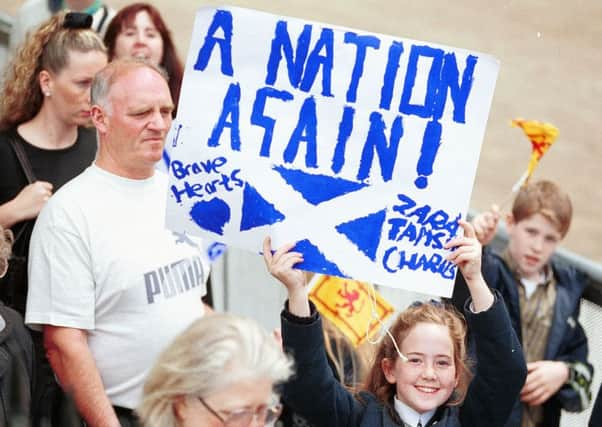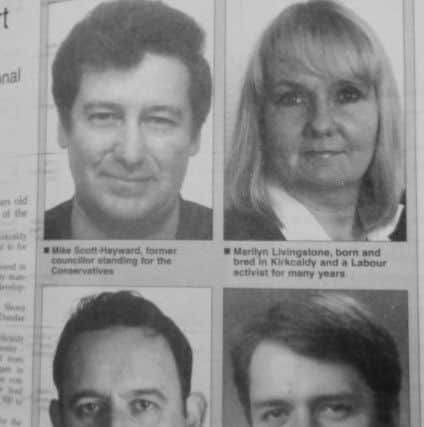Scottish Parliament 20th anniversary: Who stood first in Fife seats


Donald Dewar’s famous words captured the spirit of a great new adventure in 1997 when he launched the Scotland Bill which led to the first elections to the Scottish Parliament 20 years ago this week.
He was the founding faither of Scottish devolution which led to that historic first election on Thursday, May 6, 1999 – and Scotland’s first First Minister.
Advertisement
Hide AdAdvertisement
Hide AdThe historic poll gave Scotland its own parliament for the first time since 1707.


The 129 new MSPs were based in the General Assembly on The Mound while a new building was constructed at the foot of the Royal Mile – a £414m development that ran hopelessly over budget and didn’t open until 2004.
You may also be interested in:
Many of the politicians came from local government as councillors stepped up a level to run the country.
Advertisement
Hide AdAdvertisement
Hide AdBallot papers for the four Fife seats were packed with some weel-kent names and faces.
Dunfermline East saw Helen Eadie stand for Labour, while in the west of the town Douglas Chapman flew the flag for the SNP. Ted Brocklebank was the Tory choice in north-east Fife, up against Iain Smith of the Lib Dems.
In Kirkcaldy, it was a four-way fight of the established political parties.
Marilyn Livingstone took the seat for Labour to become one of 49 female MSPs elected to the first parliament. They were handed the rather patronising label of ‘Dewar’s Dolls’ by the media keen to find something to match the snappy “Blair’s Babes” line which came after PM Tony Blair posed with his new female MPs at Westminster. The Scottish version didn’t really stick.
Advertisement
Hide AdAdvertisement
Hide AdShe won with a solid majority of 4475 ahead of the SNP’s Stewart Hosie, although perhaps there was a hint of things to come as, that night, there was still a seven per cent swing from Labour to the nationalists.
Come 2011, and Mrs Livingstone was one of a raft of Labour MSPs swept out of office by an SNP tsunami – a result that changed the face of politics north of the border, possibly, for a generation or more.
She lost the seat by just 182 votes to David Torrance, although her own personal vote held up well on an utterly disastrous night for her party.
Mr Hosie – then convener of the Kirkcaldy SNP branch – went on to become MP for Dundee East and deputy leader of his party, while the two other candidates tried again to win a seat at local level. Mike Scott Hayward stood as a Tory and an independent, while John Mainland flew the flag several times for the Lib Dems without success.
Advertisement
Hide AdAdvertisement
Hide AdThe 1999 elections were conducted under proportional representation with a host of MSPs also elected via the party list.
That opened the door to Tricia Marwick (SNP) to take her seat in a chamber where she went on to become the highly respected first female Presiding Officer – a position also held by George Reid (SNP), another elected via the list.
That inaugural election also saw Henry McLeish win the seat for Fife Central.
He became Scotland’s First Minister in 2000 following the untimely death of Dewar, defeating Jack McConnell in a vote.
Advertisement
Hide AdAdvertisement
Hide AdHe implemented free personal care for the elderly and managed several tasks forces to impove the competitiveness of Scottish industry, but will be remembered for the ‘Officegate’ scandal which erupted one year later and ended his time in high office..
He was accused of sub-letting his constituency office without declaring it; a charge he denied with the famous phrase “a muddle not a fiddle.”
A car crash appearance on BBC’s Question Time effectively sealed his fate.
Since then a host of familiar names have made their way to the chamber at Holyrood – from Christine May to Jenny Gilruth, from Claire Baker to Willie Rennie.
Advertisement
Hide AdAdvertisement
Hide AdBut none have surely matched the drama associated with Mr Torrance’s 2011 victory.
He didn’t just claim a seat in a Labour heartland – a place where the party once weighed, rather than counted the votes – he also made political history.
On a night when Alex Salmond’s SNP party swept all before them, it was Mr Torrance’s victory that sealed an overall majority; something that was simply never meant to happen at Holyrood.
The Scottish Parliament has come a long way from those early days.
Advertisement
Hide AdAdvertisement
Hide AdThe Rainbow Alliance – a collection of colourful characters such as Tommy Sheridan the late Margo MacDonald, independents and Greens – has changed, the Tories ousted Labour as the official opposition, even if no such title actually exists, and Labour has gone through numerous leaders in its bid to reclaim a place it once ruled.
The 20 years have been anything but dull ...